Investigating the Coupling Relationship between Soil Moisture and Evaporative Fraction over China’s Transitional Climate Zone
Abstract
1. Introduction
2. Materials and Methods
2.1. Site and Dataset Descriptions
2.2. Methods
3. Results
Variations in Climatic Elements
4. Discussion
5. Conclusions
Author Contributions
Funding
Data Availability Statement
Acknowledgments
Conflicts of Interest
References
- Trenberth, K.E.; Fasullo, J.T.; Kiehl, J. Earth’s global energy budget. Bull. Am. Meteorol. Soc. 2009, 90, 311–323. [Google Scholar] [CrossRef]
- Oki, T.; Kanae, S. Global hydrological cycles and world water resources. Science 2006, 313, 1068–1072. [Google Scholar] [CrossRef]
- Budyko, M.I. Теплoвoй Баланс Земнoй Пoверхнoсти (Heat Balance of the Earth’s Surface); Gidrometeoizdat: Leningrad, Russia, 1956; p. 255. [Google Scholar]
- Koster, R.D.; Dirmeyer, P.A.; Guo, Z.; Bonan, G.; Chan, E.; Cox, P.; Gordon, C.T.; Kanae, S.; Kowalczyk, E.; Lawrence, D.; et al. Regions of strong coupling between soil moisture and precipitation. Science 2004, 305, 1138–1140. [Google Scholar] [CrossRef]
- Seneviratne, S.I.; Lüthi, D.; Litschi, M.; Schär, C. Land–atmosphere coupling and climate change in Europe. Nature 2006, 443, 205–209. [Google Scholar] [CrossRef]
- Teuling, A.J.; Hirschi, M.; Ohmura, A.; Wild, M.; Reichstein, M.; Ciais, P.; Buchmann, N.; Ammann, C.; Montagnani, L.; Richardson, A.D.; et al. A regional perspective on trends in continental evaporation. Geophys. Res. Lett. 2009, 36, L02404. [Google Scholar] [CrossRef]
- Seneviratne, S.I.; Corti, T.; Davin, E.L.; Hirschi, M.; Jaeger, E.B.; Lehner, I.; Orlowsky, B.; Teuling, A.J. Investigating soil moisture–climate interactions in a changing climate: A review. Earth−Sci. Rev. 2010, 99, 125–161. [Google Scholar] [CrossRef]
- Zhang, Q.; Yang, Z.; Hao, X.; Yue, P. Conversion features of evapotranspiration responding to climate warming in transitional climate regions in Northern China. Clim. Dyn. 2019, 52, 891–3903. [Google Scholar] [CrossRef]
- Williams, I.N.; Torn, M.S. Vegetation controls on surface heat flux partitioning, and land-atmosphere coupling. Geophys. Res. Lett. 2015, 42, 9416–9424. [Google Scholar] [CrossRef]
- Zhao, F.; Lei, J.; Wang, R.; Zhang, Q.; Qi, Y.; Zhang, K.; Guo, Q.; Wang, H. Environmental determination of spring wheat yield in a climatic transition zone under global warming. Int. J. Biometeorol. 2022, 66, 481–491. [Google Scholar] [CrossRef]
- Zhang, Q.; Wang, W.; Wang, S.; Zhang, L. Increasing trend of pan evaporation over the semiarid loess plateau under a warming climate. J. Appl. Meteorol. Climatol. 2016, 55, 2007–2020. [Google Scholar] [CrossRef]
- Qiao, L.; Zhang, Q.; Yue, P.; Jin, H. Analysis of changes in the structure of atmospheric boundary layer from non-monsoon zone to monsoon zone. Chin. J. Atmos. Sci. 2019, 43, 251–265. (In Chinese) [Google Scholar] [CrossRef]
- Zhang, L.; Zhang, Q.; Zhang, H.; Yue, P.; Li, H.; Wang, J.; Zhao, F.; Wang, Y.; Wang, J. Environmental factors driving evapotranspiration over a grassland in a transitional climate zone in China. Meteorol. Appl. 2022, 29, e2066. [Google Scholar] [CrossRef]
- Wang, K.; Dickinson, R.E. A review of global terrestrial evapotranspiration: Observation, modeling, climatology, and climatic variability. Rev. Geophys. 2012, 50, RG2005. [Google Scholar] [CrossRef]
- Trenberth, K.E.; Fasullo, J.T. North American water and energy cycles. Geophys. Res. Lett. 2013, 40, 365–369. [Google Scholar] [CrossRef]
- Ford, T.W.; Rapp, A.D.; Quiring, S.M.; Blake, J. Soil moisture-precipitation coupling: Observations from the Oklahoma Mesonet and underlying physical mechanisms. Hydrol. Earth Syst. Sci. 2015, 12, 3617–3631. [Google Scholar] [CrossRef]
- Dirmeyer, P.A.; Zeng, F.J.; Ducharne, A.; Morrill, J.C.; Koster, R.D. The sensitivity of surface fluxes to soil water content in three land surface schemes. J. Hydrometeorol. 2000, 1, 121–134. [Google Scholar] [CrossRef]
- Zhang, H.; Pak, B.; Wang, Y.; Zhou, X.; Zhang, Y.; Zhang, L. Evaluating surface water cycle simulated by the Australian community land surface model (CABLE) across different spatial and temporal domains. J. Hydrol. Meteorol. 2013, 14, 1119–1138. [Google Scholar] [CrossRef]
- Schwingshackl, C.; Hirschi, M.; Seneviratne, S.I. Quantifying Spatiotemporal Variations of Soil Moisture Control on Surface Energy balance and Near-Surface Air temperature. J. Clim. 2017, 30, 7105–7124. [Google Scholar] [CrossRef]
- Basara, J.B.; Crawford, K.C. Linear relationships between root-zone soil moisture and atmospheric processes in the planetary boundary layer. J. Geophys. Res. Atmos. 2002, 107, ACL-10. [Google Scholar] [CrossRef]
- Chen, X.; Su, Z.; Ma, Y.; Sunt, F. Analysis of land-atmosphere interactions over the north region of MT. Qomolangma (Mt. Everest). Arct. Antarct. Alp. Res. 2012, 44, 412–422. [Google Scholar] [CrossRef][Green Version]
- Bi, J.; Huang, J.; Fu, Q.; Wang, X.; Shi, J.; Zhang, W.; Huang, Z.; Zhang, B. Toward characterization of the aerosol optical properties over loess plateau of Northwestern China. J. Quant. Spectrosc. Radiat. Transf. 2011, 112, 346–360. [Google Scholar] [CrossRef]
- Liu, Y.; Huang, J.; Shi, G.; Takamura, T.; Khatri, P.; Bi, J.; Shi, J.; Wang, T.; Wang, X.; Zhang, B. Aerosol optical properties and radiative effect determined from sky-radiometer over Loess Plateau of Northwest China. Atmos. Chem. Phys. 2011, 11, 11455–11463. [Google Scholar] [CrossRef]
- Zuo, J.; Huang, J.; Wang, J.; Zhang, W.; Bi, J.; Wang, G.; Li, W.; Fu, P. Surface turbulent flux measurements over the loess plateau for a semi-arid climate change study. Adv. Atmos. Sci. 2009, 26, 679–691. [Google Scholar] [CrossRef]
- Huang, J.; Zhang, W.; Zuo, J.; Bi, J.; Shi, J.; Wang, X.; Chang, Z.; Huang, Z.; Yang, S.; Zhang, B.; et al. An overview of the semi-arid climate and environment research observatory over the loess plateau. Adv. Atmos. Sci. 2008, 25, 906–921. [Google Scholar] [CrossRef]
- Falge, E.; Tenshunen, J.; Baldocchi, D.; Aubinet, M.; Bakwin, P.; Berbigier, P.; Bernhofer, C.; Bonnefond, J.; Burba, G.; Clement, R.; et al. Phase and amplitude of ecosystem carbon release and uptake potentials as derived from FLUXNET measurements. Agric. For. Meteorol. 2002, 113, 75–95. [Google Scholar] [CrossRef]
- Li, H.; Zhang, Q.; Yue, P.; Zhang, L.; Niu, X.; Zhang, H.; Xing, K.; Jing, Y.; Shang, G. Temporal duration of the East Asian summer monsoon substantially affects surface energy exchange over the summer monsoon transition zone of China. J. Clim. 2021, 34, 4643–4660. [Google Scholar] [CrossRef]
- Vermote, E.F.; El Saleous, N.Z.; Justice, C.O.; Kaufman, Y.J.; Privette, J.L.; Remer, L.; Roger, J.C.; Tanre, D. Atmospheric correction of visible to middle-infrared EOS-MODIS data over land surfaces: Background, operational algorithm and validation. J. Geophys. Res. Atmos. 1997, 102, 17131–17141. [Google Scholar] [CrossRef]
- Allen, R.G.; Pereira, L.S.; Raes, D.; Smith, M. Crop Evapotranspiration—Guidelines for Computing Crop Water Requirements—FAO Irrigation and Drainage Paper 56; FAO: Rome, Italy, 1998; Volume 300, p. D05109. [Google Scholar]
- Li, Y.; Zhang, L.; Zhang, H.; Pu, X. Drought Monitoring Based on CABLE Land Surface Model and Its Effect Examination of Typical Drought Events. Plateau Meteorol. 2015, 34, 1005–1018. (In Chinese) [Google Scholar] [CrossRef]
- Zhang, L.; Zhang, H.; Li, Y. Surface energy, water and carbon cycle in China simulated by the Australian community land surface model (CABLE). Theor. Appl. Climatol. 2009, 96, 375–394. [Google Scholar] [CrossRef]
- Bagley, J.E.; Kueppers, L.M.; Billesbach, D.P.; Williams, I.N.; Biraud, S.C.; Torn, M.S. The influence of land cover on surface energy partitioning and evaporative fraction regimes in the U.S. southern Great Plains. J. Geophys. Res. Atmos. 2017, 122, 5793–5807. [Google Scholar] [CrossRef]
- Qiao, L.; Zuo, Z.; Zhang, R.; Piao, S.; Xiao, D.; Zhang, K. Soil moisture-atmosphere coupling accelerates global warming. Nat. Commun. 2023, 14, 4908. [Google Scholar] [CrossRef] [PubMed]
- Qiao, L.; Zuo, Z.; Xiao, D. Evaluation of soil moisture in CMIP6 simulations. J. Clim. 2021, 35, 779–800. [Google Scholar] [CrossRef]
- Dirmeyer, P.; Balsamo, G.; Blyth, E.; Morrison, R.; Cooper, H. Land-Atmosphere Interactions Exacerbated the Drought and Heatwave Over Northern Europe During Summer 2018. AGU Adv. 2021, 2, e2020AV000283. [Google Scholar] [CrossRef]

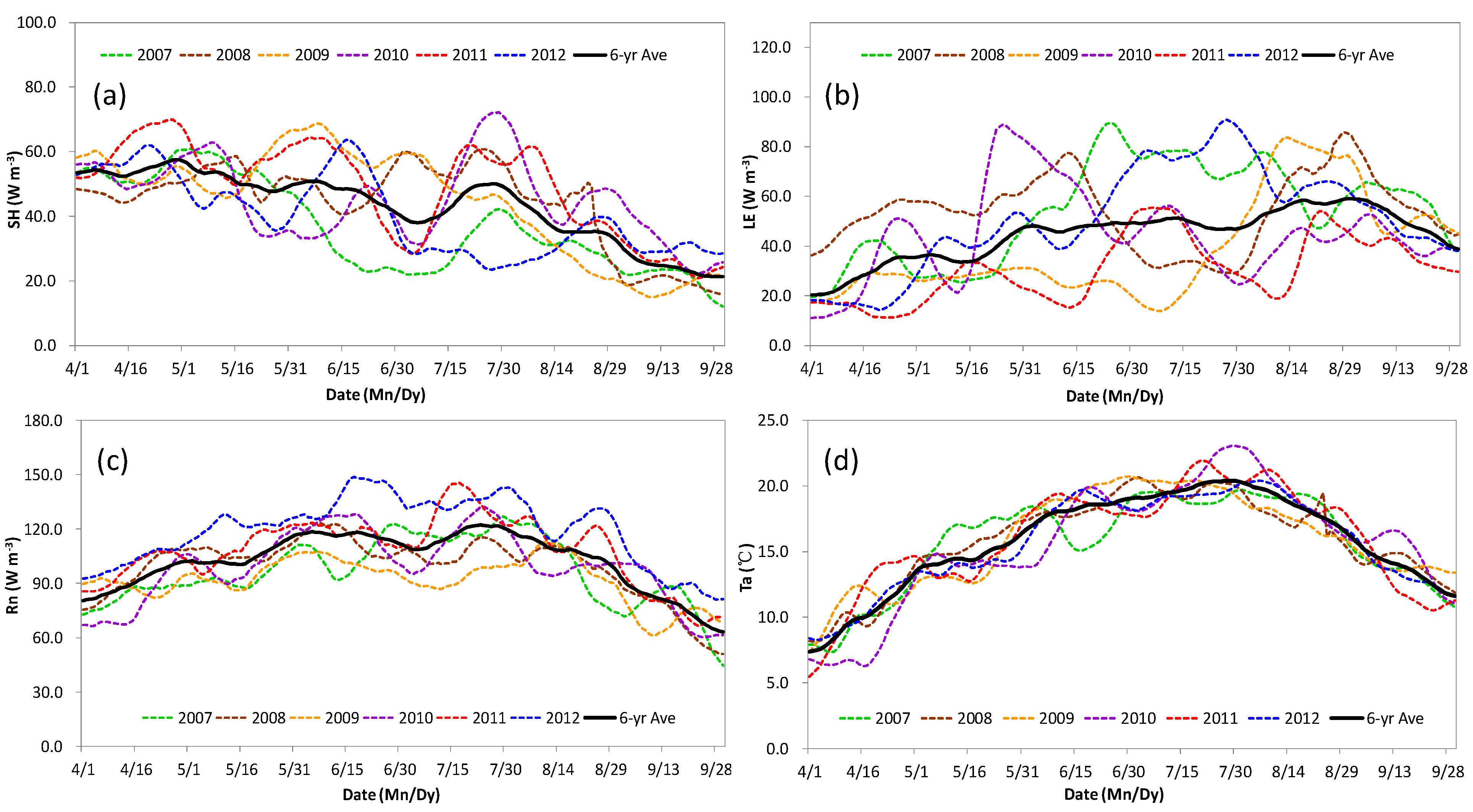
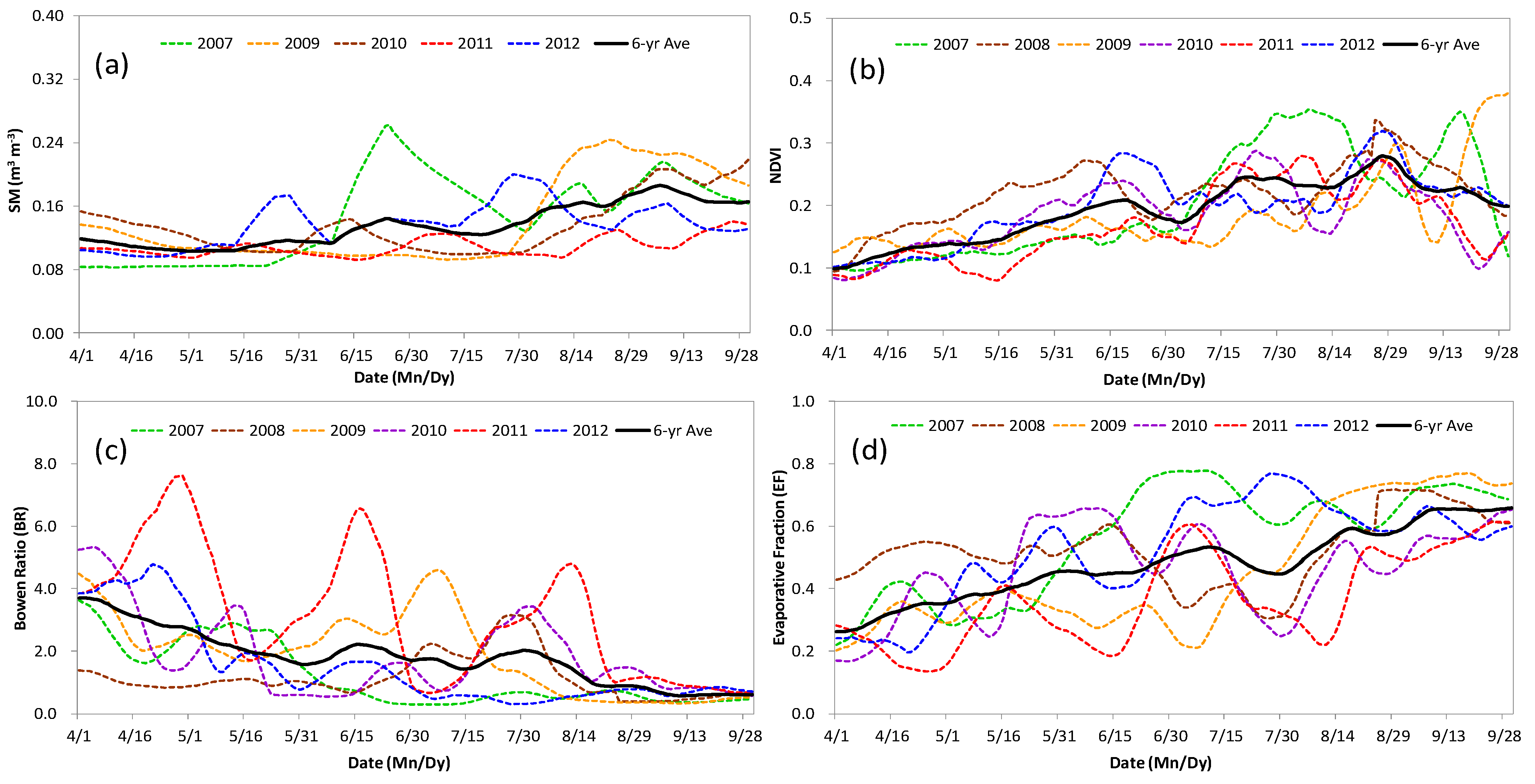


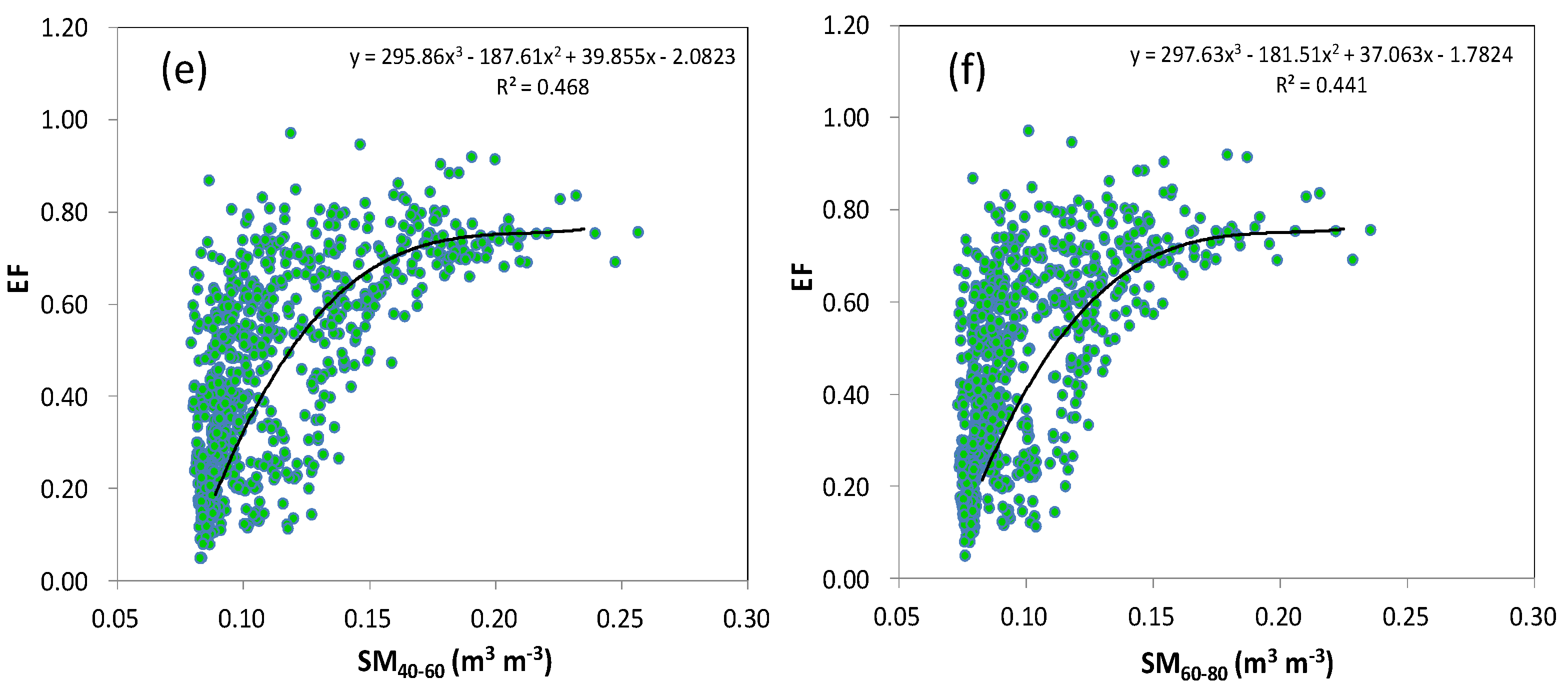
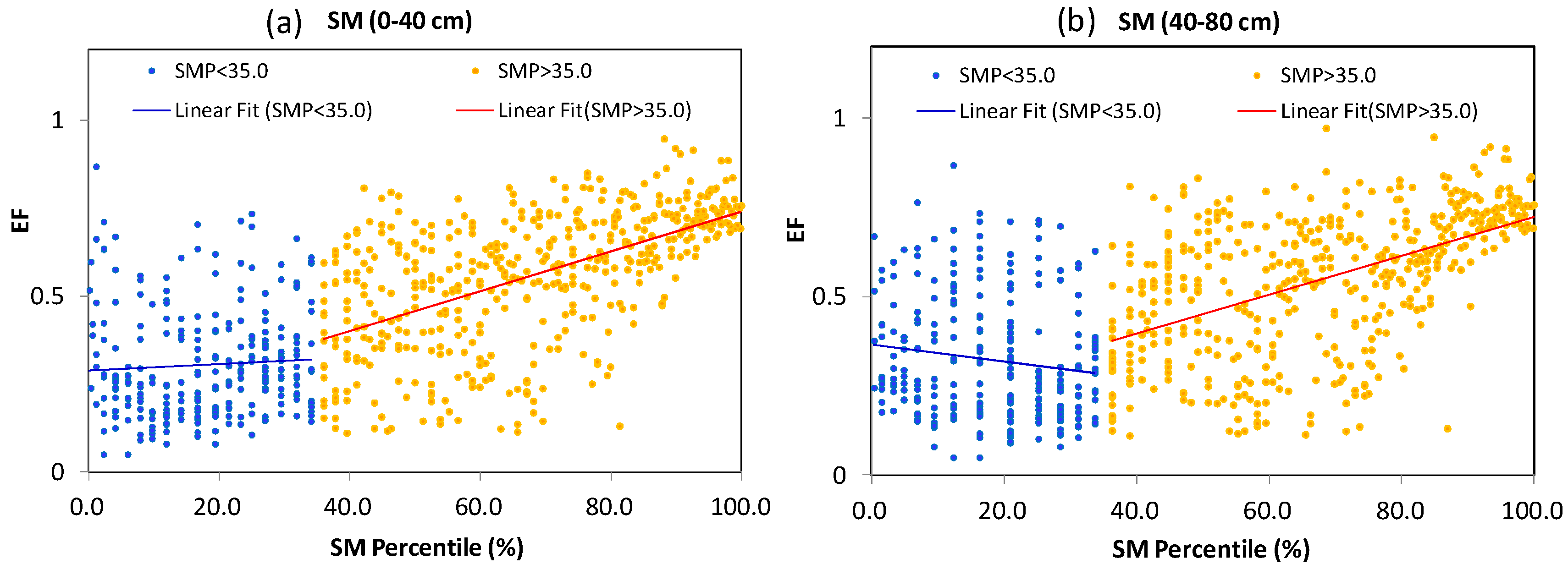

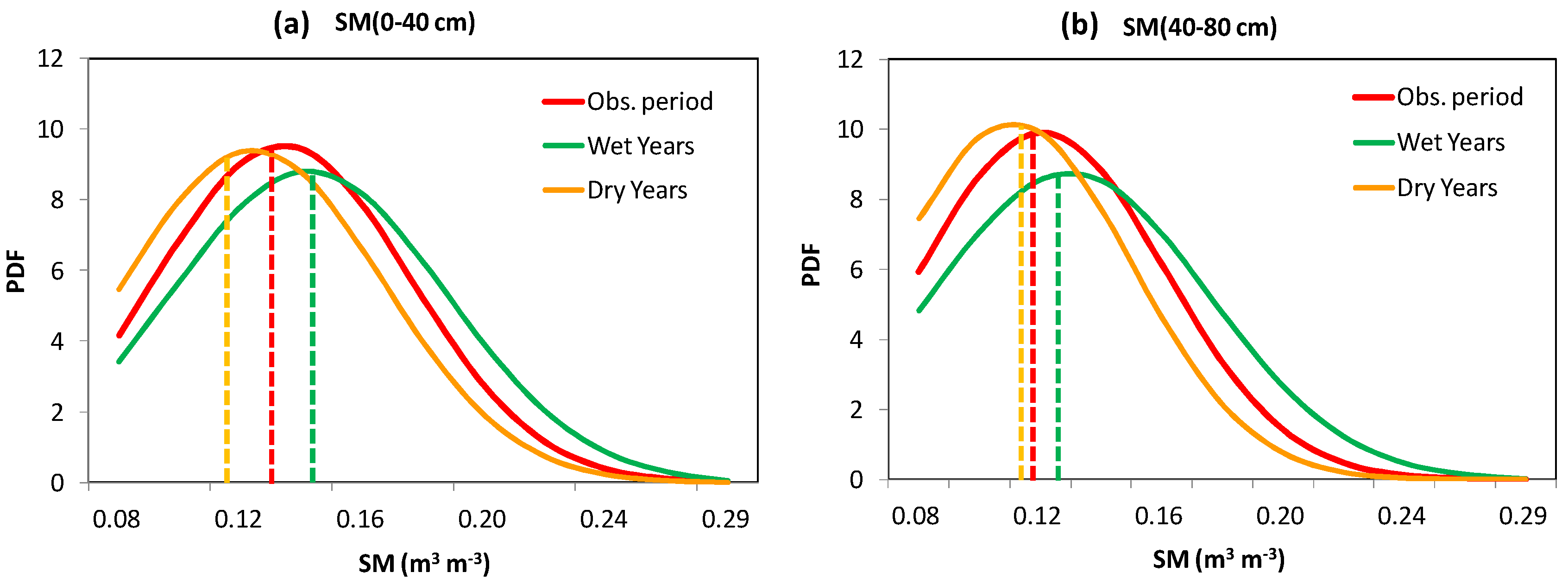

| Time (April–September) | SH (W m−2) | LE (W m−2) | Rn (W m−2) | Ta (°C) | SM40 (m3 m−3) | SM80 (m3 m−3) | BR | EF | |
|---|---|---|---|---|---|---|---|---|---|
| 2007 | Ave | 36.87 | 53.85 | 96.84 | 15.73 | 0.153 | 0.148 | 1.22 | 0.56 |
| STD | 21.16 | 28.85 | 42.03 | 4.73 | 0.058 | 0.059 | 1.24 | 0.21 | |
| 2008 | Ave | 45.46 | 51.59 | 99.99 | 15.84 | 0.136 | 0.119 | 1.27 | 0.50 |
| STD | 22.70 | 21.20 | 42.20 | 4.75 | 0.038 | 0.030 | 1.10 | 0.15 | |
| 2009 | Ave | 36.37 | 55.34 | 97.99 | 16.06 | -- | -- | 1.98 | 0.44 |
| STD | 25.49 | 24.73 | 40.94 | 4.20 | -- | -- | 1.72 | 0.23 | |
| 2010 | Ave | 45.08 | 42.86 | 99.64 | 15.75 | 0.135 | 0.121 | 1.91 | 0.45 |
| STD | 22.80 | 24.21 | 44.84 | 5.44 | 0.027 | 0.022 | 1.80 | 0.20 | |
| 2011 | Ave | 48.94 | 30.33 | 108.61 | 16.03 | 0.109 | 0.092 | 2.27 | 0.36 |
| STD | 25.59 | 19.86 | 48.07 | 4.97 | 0.015 | 0.004 | 2.31 | 0.20 | |
| 2012 | Ave | 40.34 | 50.09 | 110.43 | 15.74 | 0.138 | 0.116 | 1.54 | 0.52 |
| STD | 21.49 | 28.69 | 49.82 | 4.21 | 0.034 | 0.026 | 1.78 | 0.21 | |
| 2007–2012 | Ave | 42.18 | 47.35 | 103.75 | 15.86 | 0.135 | 0.121 | 1.70 | 0.47 |
| STD | 23.21 | 24.59 | 44.65 | 4.72 | 0.038 | 0.032 | 1.66 | 0.20 |
Disclaimer/Publisher’s Note: The statements, opinions and data contained in all publications are solely those of the individual author(s) and contributor(s) and not of MDPI and/or the editor(s). MDPI and/or the editor(s) disclaim responsibility for any injury to people or property resulting from any ideas, methods, instructions or products referred to in the content. |
© 2023 by the authors. Licensee MDPI, Basel, Switzerland. This article is an open access article distributed under the terms and conditions of the Creative Commons Attribution (CC BY) license (https://creativecommons.org/licenses/by/4.0/).
Share and Cite
Zhang, L.; Sha, S.; Zhang, Q.; Zhao, F.; Zhao, J.; Li, H.; Wang, S.; Wang, J.; Hu, Y.; Han, H. Investigating the Coupling Relationship between Soil Moisture and Evaporative Fraction over China’s Transitional Climate Zone. Hydrology 2023, 10, 221. https://doi.org/10.3390/hydrology10120221
Zhang L, Sha S, Zhang Q, Zhao F, Zhao J, Li H, Wang S, Wang J, Hu Y, Han H. Investigating the Coupling Relationship between Soil Moisture and Evaporative Fraction over China’s Transitional Climate Zone. Hydrology. 2023; 10(12):221. https://doi.org/10.3390/hydrology10120221
Chicago/Turabian StyleZhang, Liang, Sha Sha, Qiang Zhang, Funian Zhao, Jianhua Zhao, Hongyu Li, Sheng Wang, Jianshun Wang, Yanbin Hu, and Hui Han. 2023. "Investigating the Coupling Relationship between Soil Moisture and Evaporative Fraction over China’s Transitional Climate Zone" Hydrology 10, no. 12: 221. https://doi.org/10.3390/hydrology10120221
APA StyleZhang, L., Sha, S., Zhang, Q., Zhao, F., Zhao, J., Li, H., Wang, S., Wang, J., Hu, Y., & Han, H. (2023). Investigating the Coupling Relationship between Soil Moisture and Evaporative Fraction over China’s Transitional Climate Zone. Hydrology, 10(12), 221. https://doi.org/10.3390/hydrology10120221






